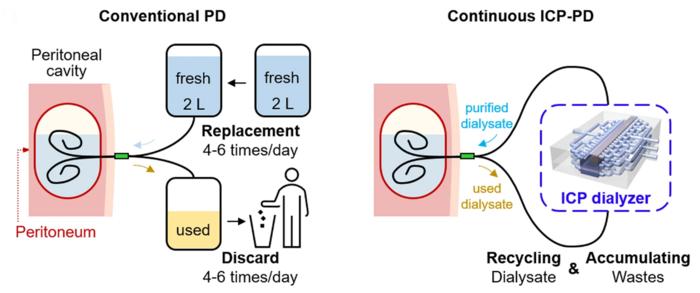Seoul National University has made groundbreaking advancements in kidney treatment technology, particularly in the development of a portable peritoneal dialysis device. This innovation emerges from a collaborative effort among esteemed faculties, notably Professor Sung Jae Kim from the Department of Electrical and Computer Engineering, alongside partners from Seoul National University Hospital and Hallym University. The device signifies a monumental leap forward in how kidney failure could be managed, especially for patients who rely on rigorous and often burdensome treatment routines.
As reported in the Journal of Nanobiotechnology, the increasing prevalence of patients suffering from kidney failure highlights the urgent need for more effective dialysis solutions. Traditional hemodialysis methods, while effective, are inherently restrictive, requiring patients to dedicate substantial hours multiple times a week in clinical settings. This not only impacts their mental and emotional welfare but also poses significant limitations on their daily activities, constraining their quality of life to a series of appointments dictated by medical necessity.
In response to these limitations, the research team has shifted focus to peritoneal dialysis, a less intrusive alternative that utilizes the body’s own peritoneal cavity to filter waste. This method allows for the administration of dialysis fluids directly into the abdomen where molecular exchange can facilitate the removal of toxins from the bloodstream. Such an approach grants patients the flexibility to manage their treatment within the comfort of their home or other environments, radically improving their daily experience.
Recent milestones in this research include the development of a unique wearable peritoneal dialysis device. This apparatus continuously purifies used dialysis fluid and reinfuses it into the peritoneal cavity, thus maintaining efficient waste removal without the constant need for external medical intervention. The innovation introduces an advanced purification mechanism that leverages ion concentration polarization (ICP), a process that captures and isolates waste products through the application of an electric field. By manipulating Coulomb forces, the device can achieve processes previously deemed unfeasible in compact formats.
The significance of ion concentration polarization lies in its ability to create a steep concentration gradient, which is crucial in enhancing the efficiency of ion and particle separation. The research team’s pivotal breakthrough involved modifying a nanoporous membrane to enhance its selective permeability. This adjustment enables the targeted removal of not only charged particles, like creatinine, but also neutral molecules, such as urea, that pose challenges for traditional dialysis methods. Such comprehensive purification can lead to a higher effectiveness of dialysis in managing waste accumulation in renal failure patients.
To operationalize the concepts of ICP in a functioning dialysis device, the research utilized a microfluidic system capable of fine-tuning fluid flow. Through experimentation, they validated their approach to accelerate ion separation, creating a viable mechanism for waste removal at the minuscule scale required for successful human application. The success of these experiments culminated in the creation of a scalable, wearable device that not only meets the ergonomics demanded by users but also performs efficiently under real-world conditions.
A notable challenge addressed by the research team was achieving an adequate flow rate of dialysis fluid, deemed essential for any practical wearable device. Through innovative design, they conceptualized a micro-mesh structure that significantly heightened the throughput of fluid. This enhancement paved the way for a three-dimensional dialysis solution that could (in tests using rat models) process fluid at rates up to one milliliter per minute, indicating its potential for real-life applications.
The implications of this research are profound. If commercialized, this portable peritoneal dialysis device could substantially alleviate the lifestyle burdens faced by kidney failure patients. By giving patients the ability to manage treatments independently and away from clinical settings, the goal is to enhance not only their physical health but also their overall quality of life. Additionally, the device’s successful implementation may contribute to lowered medical costs and reduced environmental impact due to decreased reliance on traditional dialysis methods.
Despite the promising advancements, the pathway to human application is met with challenges including the need for further studies and formal assessments. Rigorous testing to ensure safety, efficacy, and compliance with regulatory standards is crucial before any commercial venture can commence. Leading figures within the research team have emphasized the critical role of ongoing investment and additional research to transform this innovative concept into widespread clinical practice.
Experts have underscored the transformative nature of this technology within the context of artificial organs. The integration of nanotechnology into medical devices harks a new era in treatment options available to chronic kidney disease patients, potentially offering avenues for improved patient satisfaction and enhanced autonomy in managing their health.
Encouraged by the groundbreaking work done thus far, both affiliated educational institutions and private research entities are keen to propel this innovation toward public availability. This determination is guided by a vision wherein end-stage renal disease ceases to dictate the terms of living for countless individuals, fostering an era of mobility and normalcy for those impacted.
As the research processes forward, the anticipation surrounding its imminent launch underscores a pivotal moment in both medical science and patient care. Researchers are optimistic that collaboration and continued advancements in technology will eventually yield even more refined iterations of dialysis solutions, ultimately granting patients greater control over their health and lifestyle.
The journey of developing a portable peritoneal dialysis device remains a testament to the collaborative spirit of innovation and responsiveness to pressing health needs. It stands as an example of how targeted research can yield actionable solutions that have the potential to redefine healthcare paradigms globally.
Subject of Research: Portable peritoneal dialysis device development
Article Title: Scalable ion concentration polarization dialyzer for peritoneal dialysate regeneration
News Publication Date: 29-Mar-2025
Web References: http://dx.doi.org/10.1186/s12951-025-03294-1
References: Journal of Nanobiotechnology
Image Credits: © Journal of Nanobiotechnology
Keywords
Portable dialysis, ion concentration polarization, wearable device, kidney disease, medical technology, patient care, peritoneal dialysis, nanotechnology, healthcare innovation, chronic kidney disease.




